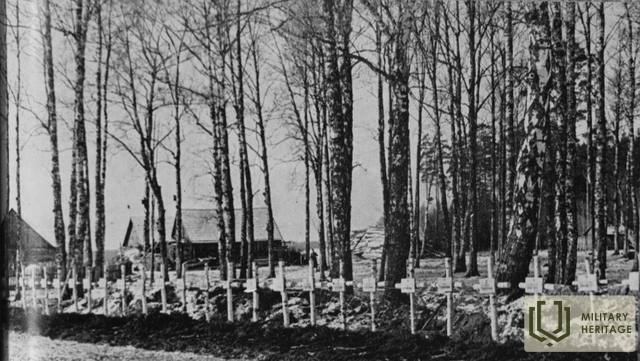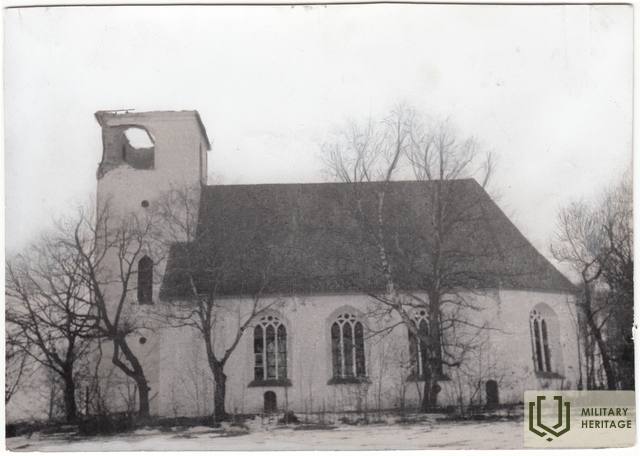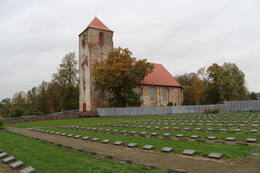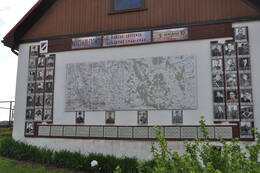Mūšiai Kuršo tvirtovėje netoli Lestenės

Pasakotojas aprašo savo įspūdžius apie mūšius Lestenės apylinkėse ir Latvijos 19-osios divizijos vaidmenį mūšiuose.
„(..) Po penkių didelių mūšių Kuršo gynėjai tiki, kad blogiausia jau praeityje, todėl tvirtai laikosi savo pozicijų, kad nepraleistų progos išlaisvinti tėvynę kapituliuojant Vokietijai.
Daugelis abejojančiųjų grįžo į savo dalinius, tačiau vis dar registruojasi nauji kovotojai – tiek iš Kuršo, tiek iš pabėgėlių. Taip pat iš Vokietijos buvo atsiųsta keli tūkstančiai Latvijos kareivių juos pastiprinti.
Kovo 14 d. vykstu į 43-iojo pulko štabą, kur turiu prisistatyti. Pakeliui sutinku generolą Bangerskį, atvykusį į Kuršą. Atrodo, kad ir pilkasis kareivis labiau nei bet kada tiki, jog artėja labai lemiamas momentas mūsų šaliai, todėl ir savo štabą laiko Kurše. Generolas primena, kad kaip septynis kartus sužeistas vyras, išsekęs fronto linijos laimę, turėčiau kreiptis į jį į komendanto pareigas. Žinoma, dar turiu apie tai pasikalbėti su divizijos vadu.
Pulko štabe juntamas jaudulys. Pulko vadas pulkininkas Osis palieka pulką. Bet kurią akimirką gali atvykti majoras Reinholdas, kuris, įsakymu, privalo perimti pulko vadovavimą. Taigi, dar vienas pulkininkas prarado savo vietą. Pirmasis buvo Lobe prieš keturis mėnesius.
Pagaliau atvyksta Reinholdas ir perima pulko vadovavimą. Esu paskirtas kuopos vadu kapitono Bumbier batalione. Kuopa ilsisi ir yra rezerve bataliono štabe. Bataliono vado pavaduotojas leitenantas Jaunzemsas yra senas kovos vilkas ir moka labai detaliai papasakoti apie padėtį fronte. Bolševikai yra Lestenės mokykloje, iš kurios nuo kalvos gerai matome savo pozicijas, todėl vos pasirodžius net ir mažiausiai grupelei, jie pradeda šaudyti iš granatsvaidžių.
„Ne, taip negali likti“, – samprotaujame ir žvalgomės, kaip išmesti rusus iš mokyklos.
Pati Lestenė yra pagrindinė kovos linija. Be manęs, kuopoje yra tik vienas kitas karininkas – leitenantas Zutis. Kuopoje vyrų taip pat mažiau nei šimtas. Bolševikų kalbėtojai kiekvieną dieną ragina sudėti ginklus, kalba apie Rygą. Čia kalba Lilita Bērziņa, čia Lācis, čia kitas viešai žinomas asmuo.
Kovo 16-17 d. naktį mus pakeičia vokiečių daliniai ir mes keliaujame į naujus apkasus, kur priešui pavyko įsiveržti. 19-oji divizija, jei taip galima pasakyti, Kurše atlieka ugniagesių vaidmenį – kur tik kas nors nutinka, Latvijos vyrai turi skubėti ir atkurti tvarką. (..)
Paskelbta JAV mėnesiniame žurnale „Daugavai vaagi“. Leitenanto Roberto Ancano prisiminimai apie mūšius Kurše „Kareivis pasakoja“.
Susijusi laiko juosta
Susijusios vietos
Kuržemės įtvirtinimų gynėjų atminimo akmuo
Įsikūręs Tukumo rajone, A9 greitkelio pakraštyje, 500 m nuo posūkio į Lesteni Rygos kryptimi.
Memorialas buvo įkurtas 1991 m. netoli Rumbu namų, kurie buvo aktyvių karo veiksmų vieta. Tai duoklė „Kuršo tvirtovės“ gynėjams, kovojusiems su Raudonąja armija Antrajame pasauliniame kare. Mūšiai buvo reikšmingi, nes laikinai sustabdė Raudonosios armijos įvykdytą visišką Latvijos okupaciją. Maždaug 300 000 latvių emigravo, bėgdami nuo sovietų režimo įvykdytų nusikaltimų prieš civilius gyventojus.
Antrojo pasaulinio karo pabaigoje Latvijos teritorijoje susiklostė savotiška situacija. Kurše buvo dislokuotos Vokietijos armijos pajėgos, kurias Raudonoji armija bandė eliminuoti arba neleisti dalyvauti mūšiuose Rytų Prūsijoje ar aplink Berlyną. „Kuršo tvirtovė“ yra dažniausiai vartojamas terminas, apibūdinantis karo veiksmus Kurše nuo 1944 iki 1945 m. „Kuršo mūšis“ buvo Vokietijos armijos kova, siekiant atremti didžiulius Raudonosios armijos išpuolius. Kuršo tvirtovė nustojo egzistuoti netrukus po Vokietijos kapituliacijos.
Šiandien galite aplankyti memorialą ir poilsio vietą, kuri buvo populiari tarp Latvijos legionierių nuo pat Latvijos nepriklausomybės atkūrimo.
Lestenės brolių kapinės
Įsikūręs Tukumo rajone, Lestenėje, šalia bažnyčios.
Masinio kapo kūrimas Lestenėje pradėtas 1998 m. Tai antros pagal dydį karinės kapinės Latvijoje, kuriose palaidota daugiau nei 1300 Latvijos legionierių. Tik atkūrus Latvijos Respubliką atsirado galimybė perlaidoti Antrajame pasauliniame kare žuvusius Latvijos karius iš įvairių vietų.
Latvijos legionas buvo Vokietijos armijos kovinis dalinys, suformuotas daugiausia iš neteisėtai mobilizuotų Latvijos gyventojų. Kareiviai savo buvimą legione suvokė kaip kovą už Latvijos nepriklausomybės atkūrimą, nepaisant to, kad ji vyko Vokietijos ginkluotųjų pajėgų gretose, o Vokietija buvo okupavusi Latviją. Nebuvo jokios kitos karinės jėgos, kuri galėtų atidėti sovietų okupacijos sugrįžimą. Latvijos legionieriai kovojo prieš Raudonąją armiją, kuri likvidavo Latvijos nepriklausomybę, sunaikino jos armiją ir įvykdė nusikaltimus prieš civilius gyventojus. Vokietijos armijos gretose kovojo apie 110 000–115 000 kareivių, apie 30 000–50 000 iš jų žuvo mūšio laukuose.
Šiais laikais Lestenėje galite aplankyti Brolių kapą, šalia kurio stovi Lestenės bažnyčia. Tai išskirtinis baroko sakralinio meno pavyzdys. Senovinėje bažnyčios smuklėje galite susipažinti su paroda, skirta Latvijos legiono istorijai. Centrinį brolių kapo atvaizdą „Tėvynė – Motina – Latvija“ sukūrė skulptorė Arta Dumpė. Netoliese yra Lestenės dvaras, kuris iki Antrojo pasaulinio karo priklausė Latvijos armijos generolui Mārtiniui Hartmaniui.
Ekskursijas po Lestenės bažnyčią galima užsisakyti pas Lestenės evangelikų liuteronų bažnyčios parapijos kunigą Inguną Kokiną, tel. +371 29993743.
Lestenės brolių kapinės, memorialinė ekspozicija ir bunkeris
Lestenės brolių kapinės yra Tukumo savivaldybėje, Lestenėje, šalia Lestenės bažnyčios. Brolių kapinių Lestenėje statyba pradėta 1998 m. Tai antros pagal dydį karinės kapinės Latvijoje, jose palaidota daugiau nei 1300 Latvijos legionierių. Tik atgavus nepriklausomybę atsirado galimybė perlaidoti Antrojo pasaulinio karo metu žuvusius Latvijos kareivius. Latvijos legionas buvo Vokietijos armijos kovinis dalinys, sudarytas daugiausia iš nelegaliai pašauktų latvių. Kareiviai savo buvimą legione laikė kažkuo, ką reikia padaryti norint atkurti Latvijos nepriklausomybę, nepaisant to, kad jie tarnavo Vokietijos ginkluotosiose pajėgose ir kad Vokietija buvo okupavusi Latviją. Latvijos legionieriai kovojo prieš Raudonąją armiją, kuri sunaikino Latvijos nepriklausomybę ir jos armiją bei vykdė nusikaltimus prieš civilius gyventojus. Vokietijos armijos gretose kovojo nuo 110 000 iki 115 000 kareivių, o apie 30 000–50 000 iš jų niekada nepaliko mūšio lauko. Brolių kapinių pagrindinę temą „Tėvynė – Motina – Latvija“ sukūrė skulptorė Arta Dumpė. Kitoje kelio pusėje, buvusiame smuklėje, įrengta ekspozicija, skirta Latvijos legiono istorijai. Šalia jos Latvijos karininkų asociacijos vyrai, vadovaujami kapitono Jānio Slaidinio, pastatė požeminį bunkerį, kuriame parodyta, kaip kareiviai ir karininkai gyveno fronto linijose.








